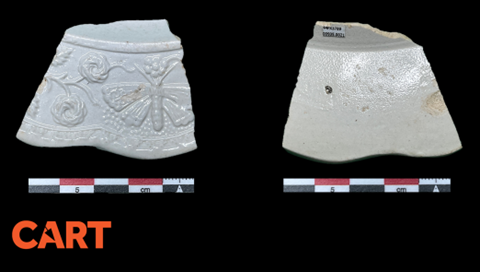Heather Hembrey, M.A., M.A.A.
June is National Pollinators Month. As gardens and wildflowers flourish, we watch and admire moths, bees, birds, butterflies, and other small creatures as they move pollen from one flower to another to fertilize plants. This month’s artiFACT is a rim sherd that archaeologists excavated in central Fairfax County. Sometime between ca. 1740 and 1770, a potter in Staffordshire, England chose to decorate this ceramic with pollinators.

This rim sherd was once part of a shallow vessel such as a plate or platter. It is made of white salt-glazed stoneware. During manufacture, white clay was pressed into a mold that featured the “Moth and Vine” pattern – an intricate arrangement of moths fluttering around flowers growing on vines. The potter threw common salt into the kiln when the temperature was at its highest. The salt’s sodium reacted with the silica in the clay, producing a hard, pitted glaze that resembles orange peel, as seen on the image to the right. English ceramic manufacturers produced molded salt-glaze ceramics between ca. 1740-1770. Rim sherds decorated with patterns such as the “Dot, Diaper and Basket” or “Barley” are found more frequently at archaeological sites than are sherds featuring moths, vines, and flowers. The Archaeology and Collections Branch is fortunate to preserve this little salt-glazed stoneware pollinator that was created in England and brought to Fairfax County more than 250 years ago.

